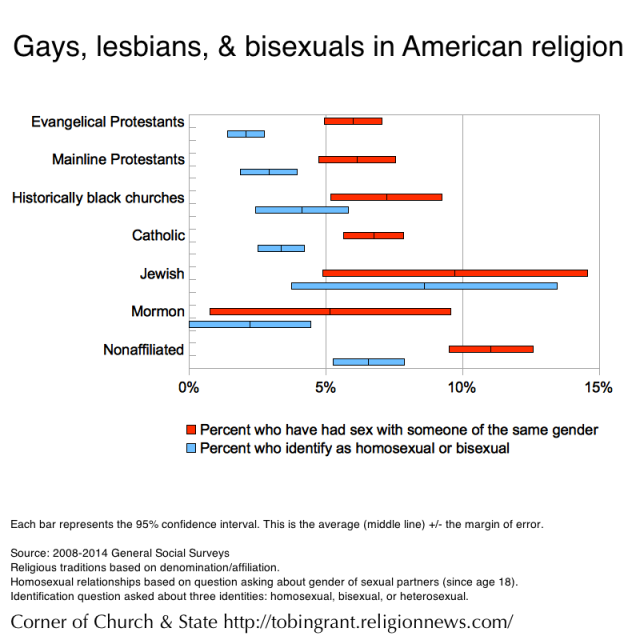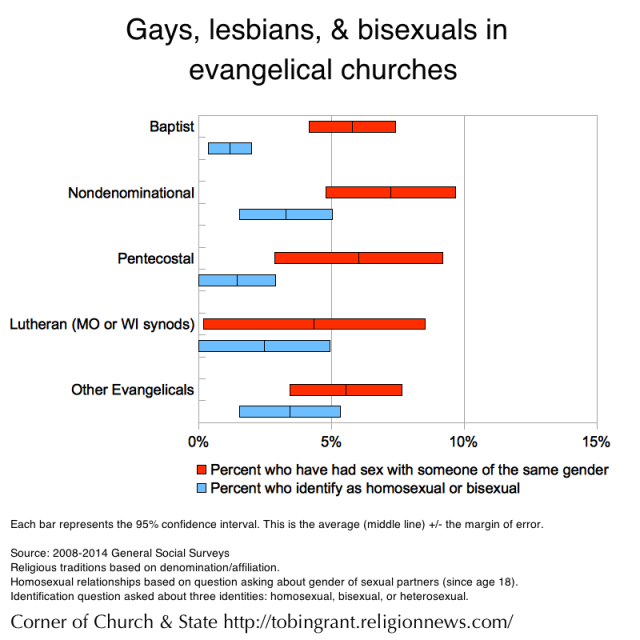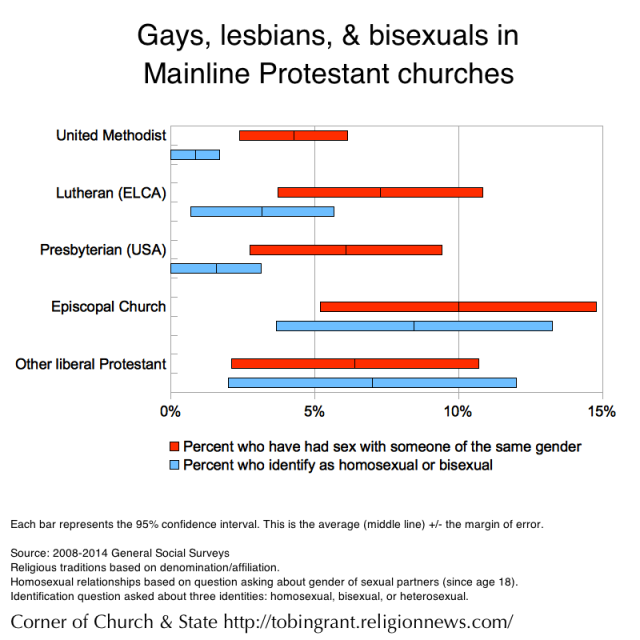One of the most contentious issues in American religion is the question of sexuality and LGBT rights. It divides denominations. It causes churches to split. For many, the issue is a litmus test for orthodoxy.
But how many people in churches are gay, lesbian, or bisexual? Way more than many would think. Even among conservative religious groups, more than five percent of religious people have had a homosexual relationship.
 The General Social Survey asks respondents a number of highly personal and sensitive questions. Using some techniques that ensure confidentiality, the GSS asks people questions about their current and past sexual partners. For the last four GSS surveys, 7.6 percent of American adults reported having at least one sexual partner of the same gender.
The General Social Survey asks respondents a number of highly personal and sensitive questions. Using some techniques that ensure confidentiality, the GSS asks people questions about their current and past sexual partners. For the last four GSS surveys, 7.6 percent of American adults reported having at least one sexual partner of the same gender.
The survey also asks each person, “Which of the following best describes you? Gay, lesbian, or homosexual, bisexual, or heterosexual or straight?” Just under four percent said they were either homosexual or bisexual.
Which measure is right—what people do or how people describe themselves? They’re both sound. But they tell us different things. Just because people have homosexual relations does not mean that they identify as gay, lesbian, or bisexual. Nearly two-thirds of people who have had homosexual sex say that they are straight (the rest are evenly split between gay/lesbian and bisexual). There are also people (about 20 percent) of people who identify as gay, lesbian, or bisexual who have never had a sexual partner of the same gender.
Looking at different religious traditions, here’s what we see:
- Each of the Christian traditions have the same percentage of people who have had homosexual relations. Over five percent of Christians have had homosexual sex.
- Far fewer Christians identify as gay, lesbian, or bisexual. As with behavior, there are few differences between different traditions.
- Jews have a higher percentage of both homosexual behavior and identity, but this could be due to the low sample size.
- Those who are not affiliated with a religion (the “nones”) are much more likely to be gay. Around 12 percent have had homosexual relations; six percent identify as gay, lesbian, or bisexual.
Unfortunately, there were not enough people in the survey to confidently say the percentages for smaller religious groups.
For some of the larger religious groups, we can further drill down the data. Among evangelicals, we see little differences between denominations and religious groups; the differences could just be due to chance.
One of the most noteworthy differences is the gap among Baptists between those who identify as gay, lesbian or bisexual and the those who have had homosexual sex. Nearly six percent report having had homosexual relations, but only 1.2 percent describe themselves as anything but straight.
As a group, mainline denominations may not be that different from other churches, but there are important differences between churches.
Among Methodists and Presbyterians, the percentage who identify as gay, lesbian, or bisexual is less than those who have had homosexual relations. For Lutherans, the difference is closer but still significant.
The story is different among Episcopalians and other liberal Protestant churches (including the Disciples of Christ and United Church of Christ). These churches have been out front on LGBT inclusion, and their members show virtually no difference between behavior and identity. These churches don’t differ (much) in what they do; they differ in how they describe themselves.
Don’t miss any more posts from the Corner of Church & State. Click the red subscribe button in the right hand column. Follow @TobinGrant on Twitter and on the Corner of Church & State Facebook page.







